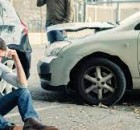A rear-end accident occurs when a rear car crashes into another that’s in front of it. It is a common type of collision with more than 1 million incidents happening annually.
Occupants of the front vehicle are always likely to suffer more severe injuries than the rear car because the former are often caught unaware. The most common injuries resulting from rear-end accidents include whiplash, back injuries, broken bones, seatbelt, and head injuries.
In most of these cases, the crashing driver is normally at fault, but this does not mean that you, as the front driver, cannot be held liable for a rear-end accident. If a front car brakes too suddenly, switches lanes without warning, or has broken tail lights, then the driver in front can be held liable for the accident, too.
Any accident can leave you confused, especially if you are not certain which driver is at fault, or multiple cars are involved. Read on to find out what you should do if you are involved in a rear-end car accident. Taking these steps will ensure safety for everyone, the law is followed, and jumpstart the insurance claim process.
Report the Accident to Authorities
Never flee after an accident. Instead, move to a safe place and call for necessary help.
Some states have made it a legal requirement for the involved parties to report a car accident. Regardless of your state’s laws, calling the authorities after a crash can improve your claims process.
Usually, the police go to an accident scene depending on the injuries, property damage, or presence of another disaster recovery personnel. If the police do not show up, you might be required to fill a form with information about the accident and submit it to the police department. Remember to ask where you can obtain a police report for the claims process as well.
Document the Accident Scene
If you are not too injured and can move around, collect any information that might help your case when proving fault. This includes taking pictures of the scene, property damage, number plates, and injuries.
If there were any eyewitnesses, consider taking down their statement and contact information as well. This is especially important if you were the front driver and did not have time to see the accident happen.
Remember to collect the other parties’ personal and insurance information but refrain from discussing the accident.
Seek Medical Attention
If you are seriously injured, remain still and wait for help. Otherwise, help any injured parties by calling an ambulance or getting them out of danger.
Injuries resulting from rear-end accidents can manifest right away or later as delayed injuries. Seek medical attention after the accident, whether you have evident injuries or not. This will not only ensure your well-being but will also favor the outcome of your claims process.
Follow through with your treatments and do not forget to store the receipts, doctor’s report, and bills safely for compensation purposes.
Contact Your Insurance Company
If you live in a no-fault state, you are required to call your insurance company after a car accident regardless of whether you were at fault.
You’ll also need to notify your insurance company if you live in an at-fault state. Your auto and health insurance coverage might have provisions to help with the medical bills and car repair associated with a car accident.
This is also the right time to seek legal counsel from a personal injury lawyer, regardless of whether you think you caused the accident. The investigation might prove otherwise and even require that the other party forego their contributory negligence settlement amount.
